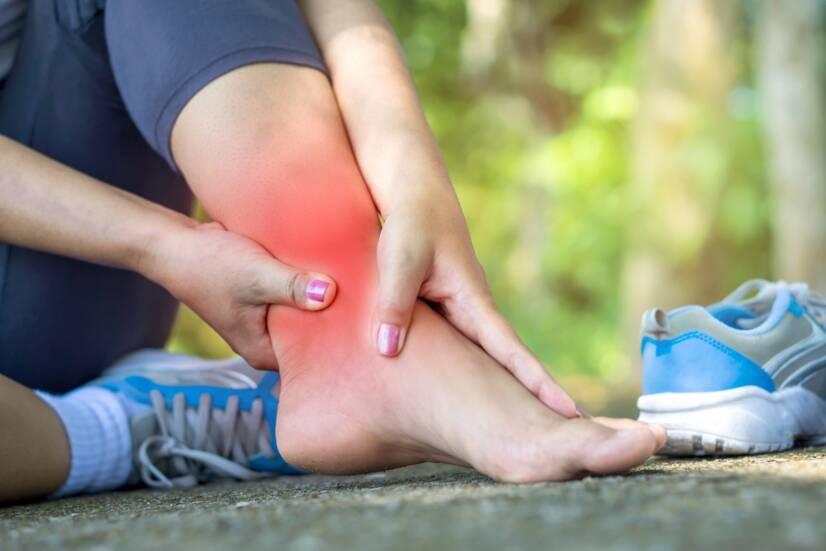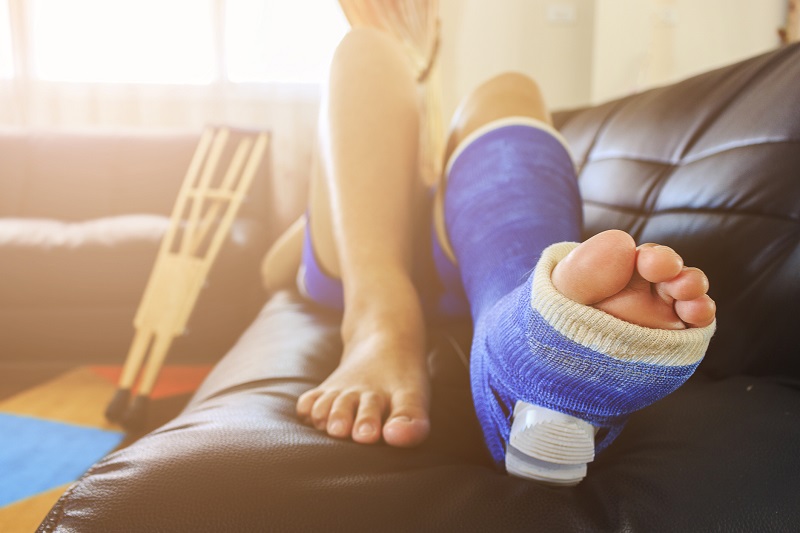- solen.sk - Bandages and braces for ankles and knees
- portal.fmed.uniba.sk - Bones from concatines
- mayoclinic.org - Ankle Pain
Ankle sprains and strains: a common problem for athletes and everyday people

Ankle sprains most often occur during sports, but can also occur in other ways. Ankle sprains are common when walking, gardening or even getting out of bed.
Article content
Ankle sprain is very often associated with sprains. Less often it occurs with fractures. Swelling is caused by injury to the ligaments and tendons in the pharynx.
What is the ankle and what is it used for?
The ankle is one of the most important joints in the human body. It connects the shin to the foot and is often the cause of many injuries. Athletes are a high-risk group, but injuries do not escape ordinary people either. The ankle is also the first joint involved in impact on the ground.
The ankle is a weight-bearing joint that connects three bones:
- the tibia.
- the fibula
- the tibia (talus)
Interesting:
The human foot has 26 bones.
Originally creeping feet, evolution has evolved feet that allow for a non-erect body.
The tibia (talus) is a bone located in the metatarsus below the tibia and fibula.
Its important role is to stiffen the body and distribute load to the arch of the foot.
Under physiological conditions, the talus is in its normal position and interacts with the bones of the tibia, foot, and distributes pressure to the heel and metatarsal bones.
The stability of the calcaneus is provided by the ligaments:
- internal ligaments
- the external ligaments
The ankle performs biomechanical movement in four planes:
- Antero-posterior - dorsal flexion, plantar flexion
- Lateral - inversion and eversion / supination and pronation
The ankle joint is the first flexion involved in the mechanics of foot impact on the mat. It thus represents a large compressive and mechanical load for the ankle.
The mechanics of the ankle joint provide compensation for uneven surfaces on which we walk or run. It also absorbs the shock and jarring caused by running, especially on uneven terrain.
Ankle injuries
A sprain (distortion) is damage to the ligaments that connect the bones on either side of the joint and the joint capsule surrounding the joint.
Sprains are most commonly associated with:
- Impact on a poorly rotated foot - when running, after a jump, while hiking
- Stepping on an uneven surface - pit, hill, frostbite
The symptoms of an ankle sprain are often the same as those of a fracture.
The sprain is accompanied by swelling and pain caused by inflammation called tendinitis. The severity of the sprain also determines the length of treatment:
- For a mild sprain - about 3 weeks
- For a more severe strain - 4 to 6 weeks
ATTENTION!
A return to sports activity is recommended after 2 months at the earliest.
The tear is identified by severe pain. It is also accompanied by swelling and a blood clot (hematoma) to an extent that usually depends on the degree of rupture. We treat the tear by immobilization for at least 6 weeks to allow the tissue to grow back. After that, we can gradually rehabilitate the ankle.
A rupture is a complete tear of the ligament. In this case, there are two options, namely:
- Surgery - suturing the torn ligament
- Conservative treatment - without the need for surgery (decided by the attending physician)
The rupture may also be accompanied by a fracture of one of the ankle bones. In this case, complete fixation of the ankle bone is necessary.
The total recovery time is 3 to 6 months!

Ankle sprain and sprain
The ankle joint bears the weight of the whole body, so the indirect injuries mentioned above are very common. The most common is an ankle sprain. Sprains most often affect athletes, especially runners, but can also occur when walking.
A sprained ankle is an injury that often occurs when the foot is stepped on or jumped on incorrectly. As a result, the ligaments strengthening the ankle are damaged.
Causes and symptoms of a sprained ankle
The ankle is the joint that connects the calf to the foot. Around it is a series of strong ligaments that increase its resistance when walking, jumping and other activities.
If the ankle moves out of its normal position, it can result in a change in its physiological position - a sprain and subsequent sprain.
The main and most common causes include:
- Improper footfall
- Uneven terrain
- Running
- Improper footwear (flip-flops, high heels)
A fall or stepping on the foot by another person can also cause a sprain.
The first symptom is inflammation. When blood seeps from the blood vessels into the soft tissues and other structures in the ankle area, the foot swells and forms what is called a sprain.
Other symptoms include:
- Swelling - is caused by a build-up of fluid in the tissue
- Redness - caused by increased blood flow in the affected area
- Pain - the nerves in this area are more sensitive, the displacement causes oppression
- pain is pronounced when changing position
- Pulsation - the so-called feeling of a beating heart at the site of the injury
Diagnosis and treatment of ankle sprain
If you have only sprained your ankle, a visit to the doctor is not necessary. However, what may at first seem like a minor condition may be more serious.
See a doctor!
If...
- You have severe pain that is not relieved by over-the-counter medications or ordinary compresses
- You can't walk - you can't even stand on your feet
- You have an altered ankle or foot shape
- The swelling does not go away even after 4 days
A definitive diagnosis is made by the treating doctor. After a visit to the GP, patients with a suspected ankle sprain are referred to a specialist - usually a traumatologist and in some cases an orthopaedic surgeon.
However, if the ankle is injured, it is advisable to visit a trauma clinic immediately.
- History - After a thorough interview, the doctor examines the foot and calf of the foot. He looks for soreness and change in range of motion in the ankle.
- Laboratory tests - From the blood, he determines the inflammatory parameters CRP (C-reactive protein), FW (Fareus westergren) and leukocyte (white blood cell) level.
- Imaging - X-ray, MRI (magnetic resonance imaging) and CT (computed tomography).
The exact treatment regimen depends on the severity of the condition and symptoms.
When treating at home, the most important thing is not to strain the ankle and strictly follow the subsequent recommendations of the doctor.
Initial home treatment according to RICE principles:
- R - rest
- I - ice
- C - compression
- E - elevation (elevated position)
Subsequent treatment most often includes:
- Rest - resting on the bed with the leg up. The affected area should be cooled with ice or a specially designed aid (gel bags) always wrapped in a cloth, e.g. a towel.
- Medical treatment - prescribed or recommended analgesics per os (painkillers), ointments, creams with anti-inflammatory or analgesic effect.
- Aids to relieve the affected limb - prescription crutches. Strict and correct compliance with the instructions set by the attending physician is an important factor.
- Aids to strengthen the affected limb - braces, splints.
Different types of bandages and braces are used to fix the injured ankle, depending on the extent of damage. They are divided into:
- Active bandages
- Stable braces
- Functional braces
- Multifunctional braces
Table with description of bandages and braces
| Active bandages | Stable braces | Functional braces | Multifunctional braces |
| Anatomically shaped | Relieving effect | Preservation of musculoskeletal mobility | Meet the requirements of modern medical care |
| Do not restrict activity | Stabilizes and supports the ankle | Acts to ensure function, mobility and regeneration | Mainly used for ligament tears |
| They have a healing effect during movement | Contain supportive elements such as iron or plastic | Ensure or protect joint function | Develop dynamic properties and the necessary degree of stability |
| Compression improves blood circulation | They can be used after surgery, they also preserve. In the field of medicine |

Care for ankle sprains
An important and major factor is prevention in the first place. Emphasis should be placed on suitable and sturdy footwear when walking, but also in the field and during sports. It is not good to rush and enough time should be set aside for the chosen activities.
If an injury cannot be avoided, it is necessary to:
- Rest - preferably on a bed with the affected limb in an elevated position.
- Use ice - regular and systematic cooling helps to eliminate a sprain
- Use aids - as recommended by your doctor, do not underestimate their importance and necessity
Nutrition and drinking are also important. It is advisable to include foods with a higher content of minerals, calcium and magnesium in the diet.
Try:
Turmeric wrap. Turmeric has strong anti-inflammatory effects and can be very beneficial as a supportive treatment.
You need:
- 2 tablespoons of turmeric
- Water - as needed
Mix the ingredients together to make a thicker paste. Rub on the ankle and wrap in food foil. Secure with a bandage.
Interesting resources










